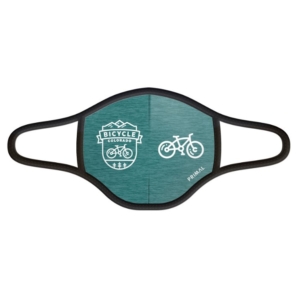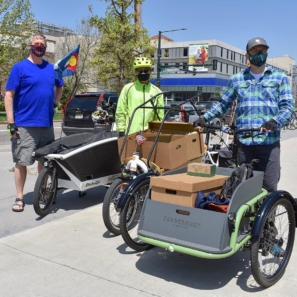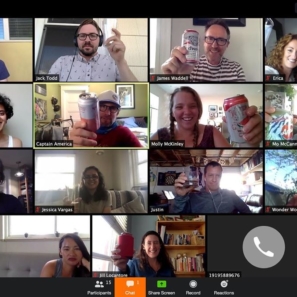Chip seal—the bumpy truth
Too late
I rode Guanella Pass recently to enjoy the aspens. Several cycling friends, who are also Bicycle Colorado members, told me to ride the pass before it was completely chip sealed. Unfortunately, the job was complete, changing the pavement from smooth to somewhat rough. I waited too long.
For those who don’t know, “chip seal” is the process of laying down an oily, tar-like adhesive on the pavement and covering it with small stones (aggregate). The stones are compressed into the adhesive and compression continues over time with the weight of motor vehicles traveling on the road.
I have never met a bicyclist who liked chip seal, particularly when applied to a smooth road that does not seem to need repair. “Why would they do that to a perfectly good road?” we say. Personally I much prefer a smooth asphalt road over chip seal.
Until I dug into the details of transportation projects and budgets, I was quick to complain about chip seal, whether riding my bike or driving my car. Stones flying at the windshield, chips to the paint of both bicycle and car plus bouncing of bicycle and body are all unpleasant.
Why chip seal?
Effective use of transportation budgets (our tax dollars) is the answer. Wouldn’t it be great if the money existed to regularly repave all roads to keep them in near new condition?
According to the Colorado Department of Transportation (CDOT) and other transportation organizations, repaving a roadway is eight to 10 times more costly than applying chip seal. Complete reconstruction including the underlying road bed is about 25 times more expensive.
And we are talking very large dollar amounts. One mile of interstate highway can cost up to $50 million or even more for major reconstruction.
Chip seal, when performed early in a road’s lifespan (1-4 years after newly paving), results in an average of 10 years (and sometimes up to 20 years) of additional life for roads. This increase in road lifespan is significantly reduced after roads begin to crack and potholes begin to appear. As a result, we lose our smooth, new pavement within a span of only a couple years.
Without chip seal, wear and tear from vehicles—particularly heavy ones—along with sun, oxidation and freeze/thaw cycles produce cracks, then potholes.
Improvements have been made
Advocacy has resulted in a noticeable improvement to chip seal specifications. Previously, aggregate with larger stones was used in this process. Bicycle Colorado pursued a change to CDOT policy, resulting in a 25 percent reduction of the size of the stones in the aggregate. In addition, new “surface seal” alternatives to chip seal are also being piloted, like sand seal, for example.
Reality check
Chip seal and surface seal will be used for the foreseeable future. I (and probably you) will be disappointed again when a new, wonderfully smooth road becomes a bit bumpy after only one or two years.
Unless hundreds of millions of additional dollars become available annually for CDOT and local governments to repave worn roads, chip seal will continue on many state and local roads. Voters in Colorado were clear in a 2013 comprehensive survey; we are not willing to pay for additional road repair and construction through any kind of additional tax. (Did you know the gas tax only funds about 50% of the cost of our roadway system? That’s a topic for another blog.)
Silver lining?
Compared to the cost of building and maintaining roads, building and maintaining dedicated bicycle infrastructure is very affordable. One U.S. city invested 50 million dollars over several years, producing 250 miles of bicycle infrastructure (as we note above, the same amount may only pay for one mile of highway.)
In addition, bicycles cause virtually no wear and tear on roads. More trips by bicycle, coupled with strong advocacy for change by Bicycle Colorado and others will accelerate the transportation system changes we desire—toward safe, enjoyable, connected routes whether traveling by bicycle, car, transit or walking. And somehow we will figure out how to lessen the impact of preventive maintenance like chip seal on our favorite routes.
Leave A COMMENT
Our twitter feed is unavailable right now.
The Latest News
view all- Mar 22, 2024
- by Bicycle Colorado
Why Colorado Should Pass SB24-065 To Reduce Distracted Driving
- Advocacy Issues,
- Bicycling in Colorado,
- Bike Law,
- Get Involved,
- Laws & Funding
- No Comments









COMMENTS (20)
Angela Dye -
I too hate chip seal – it’s uncomfortable and seems not to be evenly applied. They recently chipsealed the first 5 miles of Hwy 145/160, the San Juan Skyway used by lots of local and international cyclists, at the start of Dallas Divide between Telluride and Ridgway. It has a great shoulder which doesn’t get the vehicle traffic to pack it down well. Thanks for advocating for a better aggregate size but what about making the shoulder as smooth as the travel lanes? I know the lanes get a bit smoother due to vehicle traffic, but is there anything we can do about the bumpy shoulder? it forces me back into the travel lane because it’s so uncomfortable to ride. Thanks.
Scott Christopher -
Thanks for the comment and information, Angela. I’ll follow-up with one or two contacts within CDOT in the Regional office responsible for SW Colorado, including Dallas divide if you are interested in having outreach to them.
Transportation departments of the counties, the state and municipalities/cities typically do a good job of listening to their citizens (when presented in a diplomatic, professional manner, similar to the comments posted here). And remember, we don’t always get the answer or outcome we hope for – change takes time and multiple efforts.
It’s also valuable for transportation staff to hear from multiple members of the community – and be sure to let them know you own and drive a motor vehicle, too. It is also worthwhile to offer compliments for other aspects of their work. We are all much quicker to offer the negative criticism rather than the positive.
Thanks for making our work possible as one of our membership donors.
Mike McCarty -
Hi Scott, do you know if or when the bike path along I-70 from exit 254 to Bergen Park will be completed? And, thanks for the Chip Seal info, I was wondering why they did that.
Thanks, Mike
Scott Christopher -
Thanks for the comment, Mike. I will email you a contact at CDOT you can ask about the project schedule for the path from Genesee to Bergen Park, that will allow us to travel that section without having to be on I-70.
Bill Gray -
We can live with chip-seal if small aggregate is used, as long as it is done right. A major problem with it that I have encountered is not applying it across the entire width of the pavement. This leaves an irregular and rough transition from the chip-seal coat to the smooth asphalt along the edges.When this is done on a road that started with a beautiful three-foot-wide delineated shoulder (e.g. Colorado Highway 133, Carbondale to McClure Pass), it constitutes a crime against cyclists.
Larry V -
Thank you…very informative! One other issue though, on road paving and chip-seal…How well is handles water: I see many roads that do not handle and move the water off very well; it pools…thus causing more likelihood of damage due to freeze and erosion. The road engineers need to review and consider how water moves, sits, stays, and deteriorates the surface. I for one would rather ride on a chip-seal road that drains water..than one that is smooth, but acts like a swimming pool (the smooth roads…just on surface alone are going to fail due to moisture).
Scott Christopher -
Larry, you are correct. The drainage of water is improved on roads that are chip sealed. It’s one of the details I hadn’t dealt with until I performed additional research for this web log.
I appreciate your comment compliment.
Bill -
It would be nice if they completed the work all the way off the shoulder. Many times the do the road and just leave all the loose gravel and clumps and bumps of junk on the shoulder.
Scott Christopher -
Agreed, Bill. I have a call into the pavement engineering group at CDOT to learn more about compaction of chip seal on shoulders.
I will certainly encourage Bicycle Colorado members to offer their concerns and desires to state transportation staff.
Gordon Revey -
Scott,
In the Deerfield neighborhood located southeast of Larkspur, recent applications of chip seal have not been applied effectively. The chip seal is separating from the road creating loose and hard-to-see hazards for bicycles and motor vehicles.
There is no way that these applications are increasing the service life of these roadways. C-DOT should inspect the extremely poor product they got with our money and Contractor should fix it or remove it!
There are wide swaths of the roadway where the chip seal installed this spring/summer has completely come off the road surface. Tomichi Road is one of these cases.
Best regards and ride safe,
Gordon
Scott Christopher -
Gordon, thanks for your comment and for reading the web log on this topic. I will give you a call to continue our conversation from earlier this year and suggest next steps.
Tomichi Road is not a CDOT road, per my research. It is probably a Douglas county road and the next step is to confirm the government entity responsible for that right-of-way (road). Our colleagues at Bicycle Douglas County may be able to suggest the best county staff members to contact about the road or roads you are referring to.
By the way, thanks for your many years of membership donation support. Donors make our work possible.
Ed Carlstead -
Scott: Thank you for your article. Guanella is one of my favorite front range passes so I was especially alarmed when they started chip-sealing the perfectly good road surface this summer. I too spent some time on the telephone with CDOT and the county commissioners of Clear Creek to try to understand this insanity. Apparently there is some history extending back to the 1990’s over whether to pave the pass or not as federal funds were available for that purpose. After public comment it was decided to pave the road but to leave the surface with a “rustic” feel that locals preferred. That decision, made in the 1990’s, was set in stone, even though the actual paving project would not start for more than a decade. Why they first paved it in 2012 and then chip-sealed over the top of it this summer remains a mystery to me. I can only guess that after it was paved in 2012 someone went back and looked at the original scope of work plans and figured they needed to rough up the surface. Whatever the reason, it is clear that the 2012 surface was NOT in need of repair. I suppose we should count it a blessing that we had two good seasons of perfect pavement. And I can also now blame the road surface, rather than my lack of fitness, for having to use my granny gear to make it to the top. Ciao!
Scott Christopher -
Ed, thanks for your comment and particularly for your personal involvement in local advocacy.
You are correct that Guanella has some uniqueness to it, resulting from the agreement in the 90’s you reference to keep the road rustic.
Regardless of the Guanella details, the road still fits the (unfortunate for cycling on smooth roads) criteria for receiving chip seal, two years after paving: To prevent damage before it happens.
We would welcome your support as a member and donor – it’s how we have the financial resources to accomplish so much more in Colorado than in most states – http://www.BicycleColorado.org/get-involved/join/
Scott B -
I just did a ride in British Columbia Canada and they were chip sealing the road but not the shoulders, this made for quite nice bike riding while still providing the protection for the area that had all the heavy use. has CDOT experimented with doing this in Colorado?
Scott Christopher -
We, too, have discussed this approach and yes, CDOT has experimented with doing this in CO. One of the challenges is many of the roads that are chip sealed are not CDOT roads. The governmental jurisdiction is the federal government (in the case of Guanella) or more often one of the 64 counties or 200+ municipalities. I’d be glad to discuss more details if you would like.
Thanks for the comment and suggestion.
GR -
This looks to have made the rounds a few years ago, but fee free to contact me regarding these types of roadway topics. We have been experimenting with double chip seals in Pitkin County, along with a few other techniques.
Katie Bonomo -
Thanks, GR!
Ken T. -
Came across this article while doing a search for chipseal here in CO. Good info and helps a little to read about the why’s of using this stuff. I rode a TERRIBLE road today (I think it was in Larimer, but there’s a chance it was Weld county) which certainly did not use the reduced size rocks. And to make things worse, they used much too many of them, as rocks were flying with every car that passed, and there was substantial buildup on the roadsides. A road that I enjoy riding a couple times a year is now no longer on that list because of this.
One thing I can’t understand, is why they don’t use those big roller machines to help pack down the rocks after they are put down? I always find myself riding in the wheel tracks because they are so much smoother and more comfortable to ride. I would think packing them down would help with that.
I can certainly understand the economics behind this, but they are really killing roads for cyclists with this process.
Katie Bonomo -
Glad you found the article helpful, Ken, and I’m sorry to hear that one of your favorite rides is no longer a favorite because of the quality of the road. I’ll pass this along to Bicycle Colorado’s main CDOT contact so that we can get this on the list for our next meeting with them. Do you mind sharing which road you’re referring too so we can ask about that one specifically? You can send it to me at katie@bicyclecolorado.org. Thanks!
Rich T -
A rough estimate while cycling is that it takes 10% more effort to maintain the same speed on chip seal as opposed to real pavement. Does that mean a corresponding decrease in gas mileage for autos? If it does, the public simply pays at the gas pump rather than taxes. Where I live it seems policy to chip seal everything, sometimes even over freshly paved surfaces.